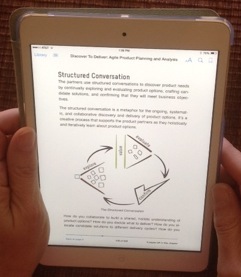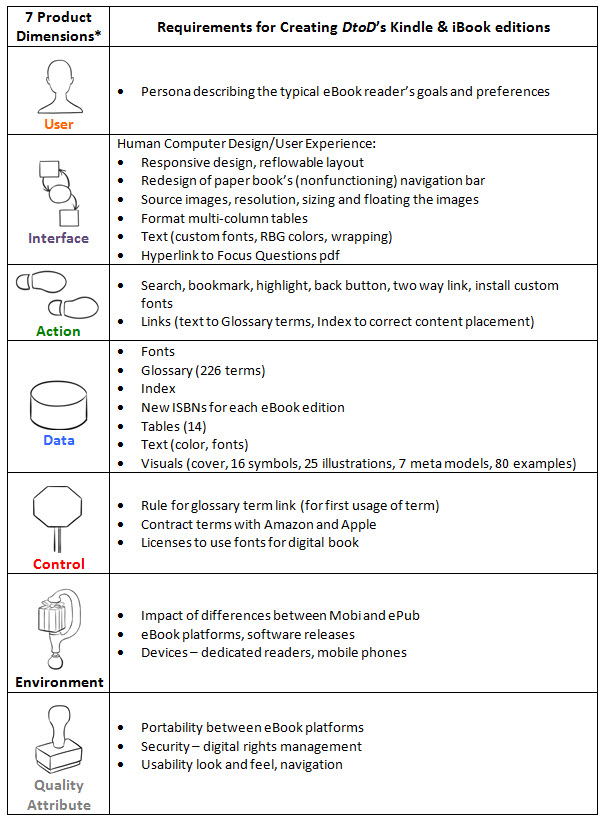Requirements to the Rescue: How the 7 Product Dimensions Saved our eBooks
By Mary B. Gorman
“Fast, easy, free/cheap…” That’s what we heard about publishing an eBook edition of a paper book. After all, people said, how difficult can it be to take a PDF and make it digital? Quite difficult, actually.
Ellen Gottesdiener and I should have anticipated that publishing eBook editions of our paper book Discover To Deliver: Agile Product Planning and Analysis would be a complex endeavor. In our careers, we have been involved in re-platforming software products (applications)–and we’ve rarely encountered a re-platforming project that is straightforward. Our eBook editions were no exception.
To eBook or Not to eBook
Even before we published the paperback version of Discover To Deliver, folks requested a digital version. We analyzed the profile of our primary readers. Challenges in converting the book’s visual language, illustrations, models and examples for a virtual reading audience worried us. Other concerns included the evolving eBook industry, its splintered standards, and the end-product usability issues driven by the increasing variations in devices (tablets, readers, smartphones) on which people access books. Weighing the value proposition of paper vs. digital, we decided to initially go paper.
Customer demand is a powerful force, though. Wherever we went, people would ask us when our eBook was coming out, even people who already had a paper copy of the book. We got emails from around the world asking for an e-version. After months of such requests, we decided we couldn’t put off it any longer. It was time to tackle converting our Discover to Deliver print-ready PDF.
The question was, how to begin. We felt overwhelmed by all our options and the endless string of challenges. All at once, we realized that the answer was right in front of us: Open the book and take our own advice. After all, what better way to get a handle on our project than to use Discover To Deliver’s practices and techniques?
Value Is in the Eyes of the Beholder
First step—use Discover To Deliver’s big concepts of Partners and Value. We know from experience that delivering a successful product requires a partnership. For example, the Discover To Deliver eBook product partnership included the readers (customers), the eBook development team (technology), and the authors and publishers (business).
No surprise, everyone didn’t share the same value considerations! The readers wanted an eBook edition for their existing devices, as we imaged they weren’t prepared to buy a new device just to read DtoD. The development team was invested in their current technology and methods.
From a business perspective we valued:
- Iterative development to minimize rework and control costs
- Minimum amount of our involvement in the development process
- Quick delivery and time to market
- Maximizing digital features for high eBook usability
- The integrity of the paper book’s rich visuals
Our expectation was the project would take 3-4 weeks. (Spoiler alert: It took months!)
Gaining Perspective with the 7 Product Dimensions
What at first blush appeared to be a limited, controlled scope (converting the print-ready PDF to eBook formats) was actually chock full of requirements. Here’s where Discover To Deliver’s 7 Product Dimensions saved the day, helping us to elicit and analyze the eBook requirements options. (The 7 Product Dimensions are User, Interface, Action, Data, Control, Environment, and Quality Attribute. For a quick introduction to the 7 Product Dimensions, you can view our two-minute animated video.)
Below, you can see how our eBook requirements options mapped to the 7 Product Dimensions. Notice that our typical eBook reader profile served as the basis for developing a persona of the User of our product. You can also begin to see how organizing our requirements across the Dimensions helped us balance tradeoffs. For example, analysis of the Environment Dimension’s options forced a number of tough decisions. Readers wanted support for their eBook formats and many associated releases, yet we needed to control costs and get to market as quickly as possible. Additionally, some of the book’s visual content displays better in one edition, while the other environment has more desirable navigation features that the other doesn’t support.
Exploring and evaluating the requirements within and across the 7 Product Dimensions helped pull us out of the quagmire of options and on to a successful release. We also used the 7 Product Dimensions to run our tests as we iterated through production of both book editions.

7 Product Dimensions Image Source: Discover to Deliver: Agile Product Planning and Analysis,
Gottesdiener and Gorman, 2012
Delivered by Discovery
Our experience creating the eBook editions of Discover to Deliver was definitely not as fast, nor as easy, as advertised. The 7 Product Dimensions helped us look at the effort holistically and enabled us to make decisions based on value. Ellen and I are pleased with the final DtoD eBook editions. But of course the most valuable feedback will come from readers like you.
Download your copy (Kindle or iBook) and tell us what you think.

Great story… I think many of us would like to see how that table varied across the different editions you mentioned. Also, if you created other of your diagrams in the process, those would be great follow on blogs worth sharing.
Oh, and thanks for m aking the book an ebook… you have the process down now and can publish smaller novella editions!
Love the _drinking your own champagne_ approach to managing the re-platforming of your book. Also, still love the book. Thanks for sharing!
thanks Scott…yes it was tough sipping at times 😉 and sometimes we just had to stop and remember to do just that!
bests,
~ ellen
Great article. Real-world, practical examples like this are almost always the best way to enhance the message. It was also helpful that you were open with your lessons learned–so we could learn from them too.
Jim K
Thanks Scott. Thanks for sharing the love 🙂
LOL!
We had (kind of) the opposite experience. We decided to only go ebook with our books and later decide whether to publish to “real books”. Creating a book from scratch using an ebook platform was tricky at first. Learning the new tool and its limitations. When you are compiling to ebub, mobi and pdf you have MANY limitations. And learning what the best choices for us, given these limitations was tricky. We are now on book 8 and its a much simpler affair. Practice makes perfect 😉
Oh, and we decided to not go the “real book” print out route …
Thanks for sharing your experience, Sam. eBook variations (based on reader and version) was quite an aggravation, and will continue to be, i think.
One of the reasons Mary and I decided to go with a physical book was the visual nature of the work itself. Readers like Kindle don’t deal with visual well at all.
It’s a changing world as far as reading, viewing, and interacting with content!